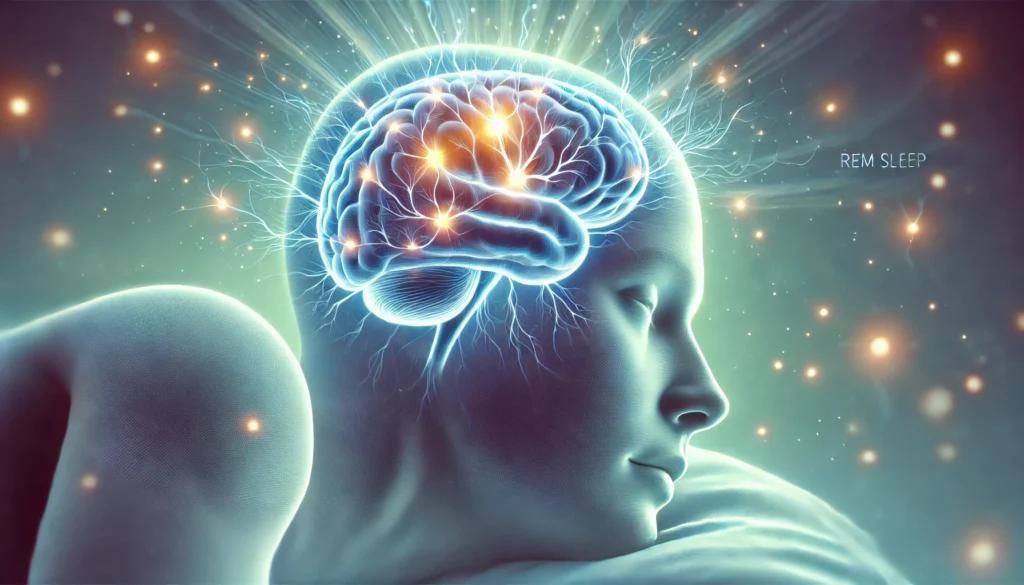Sleep is often described as the cornerstone of health and wellness, an essential pillar that supports our physical and mental well-being. Among the various stages of sleep, Rapid Eye Movement (REM) sleep holds a unique place due to its profound impact on cognitive functions, emotional regulation, and overall health. As we delve into the intricacies of REM sleep, we’ll explore how many hours are necessary, why it’s important, and the fascinating connection between REM sleep and dreaming.
You may also like: The Connection Between Sleep and Memory
Understanding REM Sleep
REM sleep is a critical phase of the sleep cycle, characterized by rapid movements of the eyes, increased brain activity, and vivid dreams. It is during this stage that the brain processes emotions, consolidates memories, and promotes creativity. REM sleep usually occurs about 90 minutes after falling asleep, with each subsequent REM cycle becoming longer throughout the night.
The Science Behind REM Sleep
The science of sleep has evolved significantly over the years, offering us deeper insights into the mechanisms of REM sleep. During this stage, the brain exhibits activity levels similar to those when we are awake. This heightened brain activity is believed to play a crucial role in learning and memory retention. Additionally, REM sleep is associated with the production of neurotransmitters such as serotonin and dopamine, which are vital for mood regulation.
The discovery of REM sleep’s unique characteristics has led to a deeper understanding of its role in the sleep cycle. Researchers have found that during REM, the brain’s electrical patterns closely resemble those of wakefulness, indicating intense neural activity. This stage is also marked by increased respiration rate and irregular heart rhythms, underscoring its dynamic nature.
REM sleep is not just about brain activity; it also involves physiological changes. The increased production of neurotransmitters during this phase has been linked to mood stabilization and emotional processing. This intricate balance of brain and body activities makes REM sleep a focal point for understanding overall sleep health.
The Stages of REM Sleep
REM sleep is one of several stages in the sleep cycle, each with its distinct characteristics. The sleep cycle begins with light sleep, progresses to deep sleep, and culminates in REM. Each cycle lasts about 90-110 minutes and repeats throughout the night, with REM stages becoming progressively longer.
The first REM stage is typically short, lasting only a few minutes. As the night progresses, each subsequent REM stage extends in duration, allowing for more comprehensive emotional and cognitive processing. The final REM stage can last up to an hour, providing ample time for dreaming and memory consolidation.
Understanding these stages helps us appreciate the complexity of sleep architecture. Each stage serves a unique purpose, contributing to overall restorative processes. REM sleep, in particular, is crucial for integrating experiences and emotions, reinforcing its significance in the sleep cycle.
REM Sleep and Brain Development
REM sleep plays a pivotal role in brain development, particularly in infants and young children. During early life stages, the brain undergoes rapid growth and neural network formation, processes that are heavily influenced by REM sleep.
In infants, REM sleep comprises a significant portion of total sleep time, supporting the development of sensory systems and cognitive functions. As children grow, the proportion of REM sleep decreases, but its importance in brain maturation remains. This developmental aspect highlights the necessity of adequate REM sleep across different life stages.
For adults, REM sleep continues to be essential for maintaining neural plasticity, the brain’s ability to adapt and reorganize. This adaptability is crucial for learning new skills, retaining information, and managing emotional responses, underscoring the lifelong importance of REM sleep.

How Much REM Sleep Do You Need?
The amount of REM sleep a person requires can vary based on age, lifestyle, and individual health needs. On average, adults should aim for about 20-25% of their total sleep time to be in the REM stage. For an average night’s sleep of 7-9 hours, this translates to approximately 90 to 120 minutes of REM sleep.
Factors Influencing REM Sleep
Several factors can influence the amount of REM sleep you experience:
- Age: Infants spend about 50% of their sleep in REM, while this decreases to about 20-25% in adults. As people age, the proportion of REM sleep continues to decline, but the quality remains crucial for maintaining cognitive health.
- Sleep Disorders: Conditions such as sleep apnea can disrupt the sleep cycle and reduce REM sleep. Sleep apnea causes interruptions in breathing during sleep, leading to fragmented sleep patterns and reduced time spent in the REM phase. Addressing such disorders is vital for restoring healthy sleep architecture.
- Lifestyle: Stress, alcohol consumption, and irregular sleep patterns can all impact REM sleep quality and duration. High-stress levels can lead to increased nighttime awakenings, cutting short REM periods. Alcohol, though initially sedative, disrupts the later stages of the sleep cycle, affecting REM sleep quality.
The Impact of Lifestyle Choices on REM Sleep
Your daily habits and routines can significantly affect your REM sleep. Engaging in regular physical activity is one way to enhance sleep quality, including the REM stage. Exercise helps regulate circadian rhythms and reduces stress, promoting more restful sleep.
Diet also plays a role in sleep health. Consuming a balanced diet rich in nutrients supports overall well-being, which in turn can improve sleep quality. However, heavy meals or stimulants like caffeine close to bedtime may hinder the ability to enter and maintain REM sleep.
Lastly, maintaining a consistent sleep schedule can help optimize REM sleep. Going to bed and waking up at the same time each day aligns the body’s internal clock, facilitating smoother transitions through the sleep stages, including REM.
The Influence of Mental Health on REM Sleep
Mental health conditions, such as anxiety and depression, can have a profound impact on REM sleep. These conditions often lead to disrupted sleep patterns, reducing the time spent in REM and affecting its quality. This reduction can exacerbate symptoms, creating a challenging cycle.
Cognitive behavioral therapy (CBT) and other therapeutic interventions can help improve sleep hygiene and mental health, thus enhancing REM sleep. Addressing mental health concerns is a holistic approach to achieving restorative sleep and overall well-being.
Furthermore, mindfulness practices like meditation have been shown to positively influence sleep quality. By reducing stress and promoting relaxation, these practices can facilitate smoother transitions into REM sleep, contributing to better emotional and cognitive health.
The Role of REM Sleep in Dreaming
Dreaming is one of the most intriguing aspects of REM sleep. The majority of our vivid dreams occur during this stage, where the brain is highly active. Dreams during REM sleep can be bizarre and surreal, often reflecting our subconscious thoughts and emotions.
Do You Only Dream in REM Sleep?
While REM sleep is the primary stage for dreaming, it is not the only time we dream. Non-REM (NREM) sleep can also produce dreams, though they tend to be less vivid and memorable than those during REM sleep. However, the intensity and emotional content of REM dreams make them particularly significant for psychological health.
Dreaming during REM is thought to play a role in emotional processing and problem-solving. The brain’s activity during these vivid dreams allows for the exploration of complex emotions and scenarios, providing a safe space for rehearsal and reflection.
The dreams that occur in NREM sleep, although less intense, contribute to memory consolidation and cognitive processing. Together, REM and NREM dreams create a comprehensive framework for mental and emotional restoration.
The Psychological Significance of REM Dreams
REM dreams are often rich in emotional content, providing insights into our subconscious minds. These dreams can reflect unresolved issues, aspirations, or fears, offering a window into our inner world. Analyzing dream content may reveal patterns that help in understanding personal challenges and emotional states.
The process of dreaming is believed to aid in emotional regulation. By simulating various scenarios and emotions, dreams allow individuals to process and integrate experiences, reducing the emotional burden during wakefulness. This function highlights the importance of REM sleep in maintaining psychological balance.
Moreover, creative problem-solving is often linked to REM dreams. The brain’s uninhibited exploration during this phase can lead to innovative solutions and new perspectives, underscoring the creative potential of dreaming.
The Link Between REM Sleep and Nightmares
Nightmares predominantly occur during REM sleep, arising from the same neural activities that produce vivid dreams. Frequent nightmares can disrupt sleep and lead to anxiety about falling asleep, affecting overall sleep quality and health.
Understanding the triggers of nightmares, such as stress or trauma, can help manage their occurrence. Techniques like imagery rehearsal therapy (IRT) involve modifying the narrative of a nightmare, reducing its emotional impact and frequency, thereby improving REM sleep quality.
Addressing underlying causes of nightmares is essential for restoring healthy sleep patterns. By creating a supportive sleep environment and addressing psychological concerns, individuals can minimize disruptions and enhance the restorative functions of REM sleep.
Why Is REM Sleep Important?
REM sleep is not just about dreaming; it plays a vital role in maintaining overall health and well-being. Here are some key reasons why REM sleep is essential:
- Cognitive Function: REM sleep enhances learning and problem-solving abilities by consolidating new information and skills. The brain’s activity during this stage supports neural connections, facilitating knowledge retention and cognitive flexibility.
- Emotional Regulation: It helps process emotions, reducing stress and anxiety levels. By allowing the brain to rehearse emotional experiences, REM sleep aids in integrating and managing emotional responses, promoting psychological resilience.
- Creativity: The brain’s heightened activity during REM sleep fosters creative thinking and innovation. The uninhibited exploration of ideas during this phase can lead to novel insights and solutions, highlighting the creative potential of a well-rested mind.
The Impact of REM Sleep Deprivation
Lack of REM sleep can lead to a range of negative effects, including impaired memory, difficulty concentrating, and mood disturbances. Chronic REM sleep deprivation has been linked to more serious health issues, such as depression, anxiety disorders, and even an increased risk of neurodegenerative diseases.
REM sleep deprivation affects the brain’s ability to form and retain memories. Without adequate REM, the brain struggles to consolidate information, leading to forgetfulness and cognitive decline. This impact is particularly concerning for students and professionals who rely on sharp cognitive abilities.
Emotional health also suffers from REM sleep deprivation. The brain’s inability to process emotions effectively can result in heightened stress and irritability. Over time, this can contribute to mental health disorders, illustrating the profound connection between REM sleep and emotional well-being.
The long-term consequences of REM sleep deprivation are alarming. Research suggests a link between insufficient REM sleep and the development of conditions like Alzheimer’s disease. This association underscores the importance of prioritizing REM sleep as a preventive measure for cognitive decline.

Future Implications and Trends in REM Sleep Research
As science continues to unravel the mysteries of REM sleep, new findings and technologies are emerging that could revolutionize how we approach sleep health. From wearable devices that track sleep stages to potential therapies targeting sleep disorders, the future holds promising advancements in our understanding and management of REM sleep.
The Intersection of Technology and Sleep
Innovations like sleep-tracking apps and smart mattresses are providing individuals with personalized data on their sleep patterns. This information can be used to tailor interventions aimed at improving REM sleep quality and overall sleep hygiene.
Emerging technologies, such as neurofeedback devices, offer potential for enhancing sleep quality. By providing real-time feedback on brain activity, these devices can guide individuals in optimizing their sleep environments and habits, promoting healthier REM sleep patterns.
The integration of artificial intelligence in sleep research is another exciting development. AI algorithms can analyze vast amounts of sleep data, identifying patterns and offering personalized recommendations for improving REM sleep and overall sleep health.
The Future of REM Sleep Therapies
Research into REM sleep is paving the way for innovative therapies targeting sleep disorders. New pharmacological treatments are being developed to enhance REM sleep quality, offering hope for individuals with disrupted sleep patterns.
Cognitive and behavioral therapies are also evolving, incorporating insights from sleep research to provide more effective interventions. These therapies aim to improve sleep hygiene and address underlying issues affecting REM sleep, promoting overall well-being.
The future of REM sleep research holds the potential to revolutionize our understanding of sleep disorders. As new treatments and technologies emerge, individuals will have access to more targeted and effective solutions for achieving restorative REM sleep.
The Role of Public Awareness and Education
Raising public awareness about the importance of REM sleep is crucial for promoting sleep health. Education initiatives can help individuals understand the impact of lifestyle choices on sleep quality, empowering them to make informed decisions.
Public health campaigns focusing on sleep hygiene can encourage healthier sleep practices, reducing the prevalence of sleep disorders and enhancing overall well-being. By prioritizing REM sleep, communities can improve public health outcomes and quality of life.
Collaboration between researchers, healthcare professionals, and policymakers is essential for advancing sleep health initiatives. By working together, these stakeholders can promote the importance of REM sleep and support the development of innovative solutions for achieving restorative sleep.

Conclusion
In summary, REM sleep is a vital component of a healthy sleep cycle, contributing significantly to cognitive function, emotional well-being, and creativity. Understanding how much REM sleep you need and optimizing your sleep environment can lead to profound improvements in your overall health. As research continues to advance, embracing the latest insights and technologies will empower you to achieve the restorative sleep your body and mind require.
By prioritizing REM sleep, you not only enhance your own well-being but also set the foundation for a healthier, more vibrant life. Investing in sleep health is an investment in your future, promoting longevity and quality of life. As we continue to unlock the secrets of REM sleep, the potential for enhancing our health and well-being becomes ever more promising.
Further Reading:
Important Note: The information contained in this article is for general informational purposes only, and should not be construed as health or medical advice, nor is it intended to diagnose, prevent, treat, or cure any disease or health condition. Before embarking on any diet, fitness regimen, or program of nutritional supplementation, it is advisable to consult your healthcare professional in order to determine its safety and probable efficacy in terms of your individual state of health.
Regarding Nutritional Supplements Or Other Non-Prescription Health Products: If any nutritional supplements or other non-prescription health products are mentioned in the foregoing article, any claims or statements made about them have not been evaluated by the U.S. Food and Drug Administration, and such nutritional supplements or other health products are not intended to diagnose, treat, cure, or prevent any disease.


